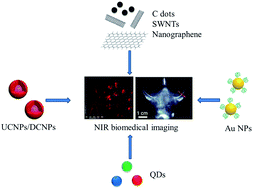NIR luminescent nanomaterials for biomedical imaging
Abstract
Luminescent labels have been widely used for biological applications, primarily in bioimaging and assays. Recently much attention has been focused on the development of luminescent nanoprobes with excitation/emission maxima falling in the region of minimal tissue absorbance/autofluorescence between 650 and 1450 nm, an “imaging window”. Tissues have minimal absorbance in this wavelength range allowing for deep penetration of light. This enables whole animal imaging with high sensitivity in core organs in real time without the need for dissection. While several excellent reviews cover various aspects of imaging, there has not been a review that covers NIR imaging nanomaterials adequately. In the present review, we will focus on nanomaterials which can be excited or emitted in NIR I (650–900 nm) and NIR II (1000–1450 nm) regions, including lanthanide based nanoparticles, carbon based nanoparticles, quantum dots and noble metal nanomaterials. We systematically summarize the recent progress in their fabrication and application in biomedical imaging, and discuss the shortcomings, challenges and opportunities in it.

- This article is part of the themed collections: Emerging Investigators, JMC B Top Picks web collection: Seeing the unseen: Advances in bioimaging and biosensors and 2014 Journal of Materials Chemistry B Hot Articles

 Please wait while we load your content...
Please wait while we load your content...